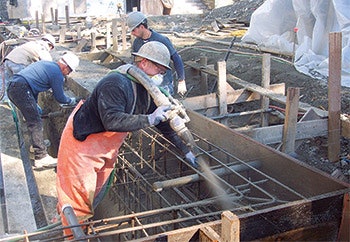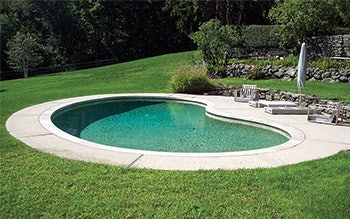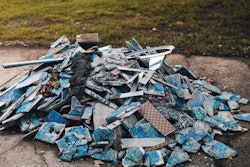It's interesting to consider the fact that the Hoover Dam, despite being built 80 years ago, has areas in its mass that are still getting stronger and will likely continue to do so. The reason for that longevity is that the concrete in the dam's massive structure is still hydrating; meaning the mix water that was added in its construction all those decades ago is still gradually chemically transforming the Portland cement in the concrete matrix.
Yes, there comes a time when the hydration process eventually stops, and like all manmade structures, the Hoover Dam will someday start to weaken. But the day that becomes an issue is likely not even on the horizon. And make no mistake; the Hoover Dam is only unusual for its size and volume of concrete. Barring very unusual conditions, all concrete that's been properly mixed, applied and cured will continue to gain strength until it's done hydrating, which can take a very long time.
BY THE BOOK
I bring this up here because contractors who build concrete pools, typically using either the wet- or dry-shotcrete methods, have a choice: We can either follow well-established guidelines that are used throughout the world of construction and create structures that can endure for generations, or we can choose to cheat the process in the name of short-term marginal gains and/or convenience, and ultimately risk creating structures that won't reliably hold water and will eventually fail.
Once you decide to commit to proper shotcrete use, the question then simply becomes what do we need to know and do in order to take advantage of concrete's remarkable physical characteristics?
To find the answer, we can easily turn to standards maintained by organizations such as the American Shotcrete Association, Portland Cement Association and the American Concrete Institute. These professional groups have long ago done the hard work of determining the guidelines for successful concrete installations (although certainly there's new information and technology that continues to emerge). Whether or not we choose to follow those rules will always be entirely up to each of us and our subcontractors.
For the purposes of this discussion, I'll stay with the recommendations and standards maintained by ACI in it's all-important standard ACI 318, "Building Code Requirements for Structural Concrete," which also serves as the basis for much of the standards maintained by ASA.
So, in short form, with established standards as a foundation, here's what we need to know:
STARTING WITH MATERIALS
 The shotcrete application technique is all-important in creating a pool shell that is not only durable, but will gain strength over time. The key to success is following well-established guidelines for mix design, application and curing.
The shotcrete application technique is all-important in creating a pool shell that is not only durable, but will gain strength over time. The key to success is following well-established guidelines for mix design, application and curing.
It's impossible to install a reliable shell made of concrete applied with the shotcrete process unless you start with the right materials. That means creating the correct mix-schedule for the installation conditions and installing the material within recommended time frames.
If you're using the wet method of shotcrete application, the material mix will be handled at the batch plant where the concrete mixing trucks are filled. Using the dry method (often mistakenly called "gunite" which is actually a proprietary process name established by the Pennsylvania Cement Gun Co. back in the early 20th century), the shotcrete crew does the mixing on site.
Either way, you have to know about mix schedules in order to either order correctly for the wet method or mix the materials on site in the dry process. There are differences between the two, but the principles remain the same.
For the sake of discussion, let's assume you're shooting a shotcrete shell. The steel is installed per the structural plan, all the plumbing is installed correctly and pressure tested and the soil has been determined to be load-bearing, meaning it works as a substrate in a one-sided form application. With all those elements in place, we start with the mix design.
First, you need to be sure that all of the raw materials, Portland cement, aggregate and admixtures such as fly ash or pozzolans, among many others, all meet ASTM C33, which dictates a variety of issues such as cleanliness, performance expectations and others.
You then need to be sure that your aggregate-to-cement ratio is within recommended proportions so that every piece of aggregate in the mix is completely encapsulated by the cement paste.
The rule is simple: you want four parts aggregate (sand) to one part cement (binder), or you can go three to one, meaning you have more cement paste to cover the aggregate. Because you're always going to experience some loss in the delivery lines and/or in overspray, we like to go with the 3:1 ratio because it ensures we'll have enough cement to cover the aggregate surfaces. Ratios greater than 4:1 do not comply with industry guidelines.
 This modest backyard pool was installed by my grandfather back in the late '50s. Although the pool has undergone aesthetic remodeling that included new tile and coping, the shell itself remains sound and watertight, all because the pool was installed in accordance with proper concrete standards.
This modest backyard pool was installed by my grandfather back in the late '50s. Although the pool has undergone aesthetic remodeling that included new tile and coping, the shell itself remains sound and watertight, all because the pool was installed in accordance with proper concrete standards.
Aggregate size is also important, keeping in mind the smaller the size, the greater the surface area that needs to be encapsulated by the cement paste. For the dry-mix process ACI recommends (gradation 1) aggregates no larger than 1/4 inch, for wet-mix (gradation 2) aggregates shall be no larger than 3/8ths of an inch.
Water-to-cement ratio is particularly important when it comes ensuring proper cement hydration. If you have too much water, you'll create porous concrete that won't have requisite compression strength, which we'll discuss below. It will be susceptible to water intrusion into the matrix, which can cause all sorts of damage later on from corroding rebar to efflorescence and any number of other problems. On the other hand, if you don't have enough water, you won't hydrate all of the cement particles, which will also compromise structural integrity.
Water to cement ratio is calculated in pounds of water divided by pounds of cementitious material. The ideal range for most applications will be between .35 and .45. ASA guidelines dictate generally no more than .50, under normal circumstances.
With proper mix design in place, we have to consider the time and distance transporting the material on its way to the nozzle and ultimately the substrate. As a general rule, without the use of retardant admixtures, you have 90 minutes in the wet-mix process from the time the material is mixed to when it's applied. We've found that with retardants, you can stretch that time frame (up to 6 hours +/-), but that does drive up the material cost, and you really need to have a grasp on concrete chemistry. Once the dry gun is loaded, a 45-minute window is typically the norm, based on the moisture content of the material.
In terms of distance from mixing truck (wet) or hopper (dry), without admixtures, you want to keep the pumping distance as short as possible. We've found that if you go much over 100 feet, you'll start to run into trouble without taking certain precautions in mix transportation (i.e. lubrication, paste content, etc.).
As a general principle, the farther you're pumping the material, the greater the cement or binder content needed. There are any number of admixture chemicals, including plasticizers, pumping aids, retardants or accelerators, that can be used to maintain viscosity for pumping, controlling the rate of hydration and promoting workability.
AT THE NOZZLE
Of the three most crucial areas in the creation of reliable shotcrete — mix design, curing and spraying — the latter is arguably the most forgiving.
That said, you still need to follow the rules as prescribed in the standards. Specifically that means the nozzle is always held at a 90-degree angle from the substrate in order to reduce rebound, at a distance of 2 to 6 feet to ensure proper compaction. If you're too far, you won't have proper compaction, too close and the material will continually spray itself off. The nozzle should also be slowly rotated to ensure full coverage of plumbing and reinforcing steel. This oscillation is determined once material exits the nozzle and nozzleman sees the rate of flow of the concrete around the steel matrix.
Air speed is another critical issue, and you need to be sure your system is operating to spec. For wet-mix applications, the system should operate at a minimum of 250 cubic feet per minute (cfm) or above, while dry-mix will require approximately 650 cfm. That equals a velocity anywhere from 350 to 400 feet per second. Velocity is key for proper in-place compaction.
When applying shotcrete, wet or dry, you always want to build the walls from the bottom up in lifts of anywhere from one to four feet. The reason being, you don't want any overspray or rebound to wind up in the structure. Ideally it's best to shoot the entire floor of the pool first, which requires more time to set up to where it's sturdy enough to be walked on, but that's not practical in jobs that take a day or less.
We often start off by shooting the coves first because we don't have to wait for the material to set up, but still want to provide a base to catch rebound and overspray. It's a simple matter of first going around the base of the walls and shooting a couple feet horizontally on the floor and vertically up the walls. Then we start shooting the walls.
(Also, out of pure practicality, we go ahead and shoot portions of steps, spas and benches intermittently so our finishers can keep busy instead of waiting around for the nozzleman to get to those points in the structure.)
There are also guidelines for outdoor temperature with 40 being the lowest, without additives, and around 90 degrees being the hottest. Although you can use retardants in temperatures higher than that, handling a nozzle is not the kind of work you want to do for very long in sweltering heat. To that point, you really want to avoid having an overly tired nozzleman, as well as the rest of the crew, because that's when mistakes happen and you run the risk of creating a substandard product. Stopping and starting again the following day, week, or year is acceptable. Shotcrete has no cold joints and no time limits. The penetration of the paste into the receiving substrate ensures that a bond at the chemical level will take place.
I'll leave off this part of the discussion with an admonition that's become familiar to many in our trade: Never, under any circumstances, should overspray or rebound be used in steps, benches or any other part of the shell. That material is not cementitious by definition and should be shoveled out or otherwise removed and discarded. Structures that are comprised of waste material are highly likely to fail and are not defensible by any existing standard. So just don't do it!
PROPER CURING
Now that we've followed the rules for both mix design and application, it's time to cure the pool.
As defined by the ASA, curing is "action taken to maintain moisture and temperature conditions in a freshly placed mixture to allow cementitious material hydration to occur so that the potential properties of the mixture may develop."
Because the hydration of concrete generates heat, known in chemistry as an "exothermic" reaction, concrete needs to be cooled so that hydration can fully take place. Fortunately, because the vast majority of hydration takes place quickly, no more than 28 days are necessary, with seven to 10 days being the acceptable norm.
You enable strength gain through interior hydration by controlling the temperature on the surface. If left uncured, the heat generated by hydration will cause the mix water to evaporate, leaving voids and depriving the matrix of the water needed to fully hydrate. Put simply, you need to keep the concrete cooled or it won't properly hydrate.
Curing does not mean putting water on concrete so it will penetrate into the matrix and become part of the hydration process, that's what the original fill water does. Instead, water on the surface of freshly installed shotcrete is used to absorb the heat generated by hydration and it helps protect the moisture content already inside the concrete matrix from evaporating rather than doing the work of hydration.
There are a number of acceptable techniques including using soaker or sprinkler hoses (our method of choice) or you can use misters, foggers or even wetted burlap. So long as the surface stays wetted evenly, it doesn't really matter how you add the water.
Note: In areas impacted by drought where using water for curing is either discouraged or prohibited, there are also curing compounds you can apply to the surface. Like any other added chemical, using them drives up the cost, but it is an option.
THOUGHTS ON COMPRESSION
All of this process leads to the end product, which according to ASA and ACI should have a minimum compressive strength of 4,000 psi (many applications require higher, but none lower).
The subject of compression strength is controversial within the pool industry and it's not my intention in this discussion to fan those flames but instead to simply let the standards, the rule book per se, stand alone on merit.
Far beyond any sort of polemic on the subject, this statement from ASA offers a perspective that is useful when considering the target compression value: "Barring significant errors in material batching in application of the shotcrete or in curing, one simply cannot avoid producing water-retaining shells with these higher compressive strengths."
It's only when the process is somehow compromised by, for example, using a higher aggregate to mix ratio in order to save on cement cost or neglecting the curing process that weaker shotcrete is created.
The bottom line is that only by diligently following the rules for shotcrete use can we build structures of enduring strength.
Comments or thoughts on this article? Please e-mail [email protected].











































